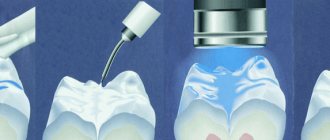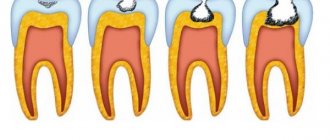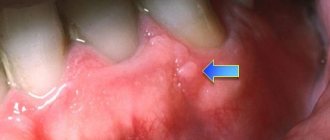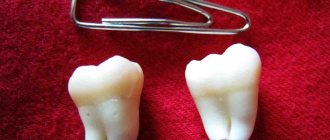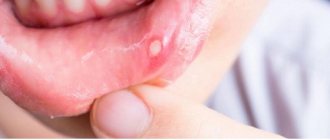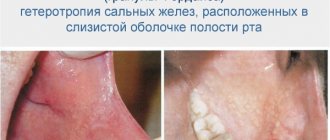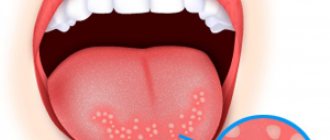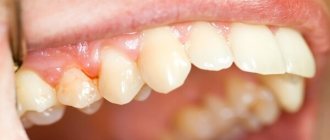People's reluctance to regularly visit the dentist often leads not only to problems with teeth and gums, but also to the occurrence of more serious diseases.
Small tumors that are not detected in a timely manner can cause the development of cancer in the oral cavity.
In most cases, the pathology progresses quickly and requires immediate treatment to preserve not only health, but also human life.
What causes papillomas to form in the mouth?
There are not many reasons why growths appear in a person’s mouth. In most cases, the papilloma virus is to blame, which provokes the appearance of warts on the hands, face and even in the mouth. Almost all of us have a small amount of this infection in our bodies. During colds and low immunity, the virus manifests itself in the form of formations of various sizes. As for the reasons for papillomas entering the body, they are very banal:
- using other people's toothbrushes, towels and washcloths;
- maintaining an active sex life with different partners;
- food from shared utensils that have not been sanitized;
- refusal to wash hands before meals.
It is far from certain that the person who transmitted the virus to you will also be completely covered in warts. It is quite possible that his body contains a very large amount of papilloma, but high immunity does not allow the infection to do its work. It is worth understanding that almost 80% of people on the planet are infected with this virus, but only a few develop skin lesions or growths in the mouth. Therefore, the cause of the disease is not the papilloma itself, but a low level of immunity.
Phases of tumor development
The formation of malignant tumors goes through several cycles:
- Elementary;
- Active;
- Launched.
Each of these cycles has its own characteristics. At the initial stage, small ulcers or lumps begin to appear from the inside, near the cheekbone, under the cheek, which harden, forming balls that cause some discomfort to the patient. There are no other obvious symptoms yet.
During the active cycle, the ulcers transform into fissures. The patient becomes lethargic and apathetic, often has a headache, and sudden weight loss is possible. At this stage, cheek cancer is easy to diagnose, and dentists are often the first to notice these symptoms.
At an advanced stage, metastasis usually occurs and the success of treatment at this stage is very doubtful.
Factors provoking the risk of development
If you want white growths in your mouth to stop bothering you, you will first have to study what exactly provokes their appearance. Yes, in most cases the cause of everything is reduced immunity. However, the weakening of the body's protective functions can also be caused by something. So to prevent the development of papilloma, you must refrain from the following actions in the future:
And these are just the main factors that can lead to the development of the virus. In addition, if you already have warts in your mouth, doctors recommend limiting your intake of too hot food, as it can destroy the oral mucosa. Also, you should not allow the development of chronic inflammatory processes, otherwise the wart can only be removed surgically in a clinic.
Prevention
The main preventive value in the fight against cancer of the oral mucosa is giving up bad habits. You should definitely quit smoking, chewing betel nut, and drinking nasvay. It is recommended to give up alcohol.
Reducing trauma to the cheeks, tongue, and gums also reduces the risk of tumors in the described localization. All teeth must be treated, installed fillings must be processed. If you need prosthetics, you should select the prosthesis very carefully so that it is easy to use and does not cause discomfort.
Foods with irritating effects should be excluded from the diet, and very hot foods should not be consumed. When the first signs and symptoms of oral cancer appear, you should immediately contact a specialist.
To reduce the likelihood of cancer, people employed in hazardous industries should actively use personal protective equipment - protective clothing, respirators.
Regularly, at least once a year, and if precancerous conditions are detected every quarter, you need to undergo preventive examinations with a dentist and oncologist.
Types of neoplasms
To understand exactly how to cure papilloma, you must first find out which group of growths the wart belongs to. In most cases, this can be recognized by what exactly led to the onset of the disease. In addition, it is important to consider the appearance of the education.
- Epithelial hyperplasia. This type of growth, as a rule, is expressed in the form of a small red neoplasm. If you press on it with your finger, you can easily move the wart from its place. The most common site of localization is the upper surface of the tongue.
- Elementary or vulgar papilloma. This growth has a pineal shape with a thin base. A distinctive feature of the formation is that in most cases it is formed on the soft palate. It grows in size quite quickly. When pressed, it moves from place to place.
- Flat papillomas. One of the rarest types of formations, which in most cases occurs on the gums. A distinctive feature is the granular surface, which is practically invisible against the background of the red color of the mucous membrane.
- Filiform papillomas. It is also a very rare formation that has very thin skin. In most cases, such warts are injured in the initial stages of formation, as a result of which they begin to quickly increase in size.
- Genital warts. The reason for their appearance in most cases is the same - unsafe sexual contact with an infected partner. The growths can unite with each other, forming entire tumors with an uneven tuberculate surface.
Depending on what type of skin lesion you have, treatment methods will vary greatly. This is why it is so important to visit the clinic if warts are noticed in the oral cavity. It is possible that a drug intended to treat a certain type of formation simply will not be suitable to cure your case.
Stages of the disease
Stage I is characterized by the presence of a tumor up to 1-2 cm in diameter, not extending beyond the affected area (cheek, gums, palate, floor of the mouth), limited to the mucous membrane. Metastases are not detected in regional lymph nodes.
Stage II - a lesion of the same or larger diameter, which does not extend beyond any one part of the oral cavity, but extends into the submucosal layer. There are single metastases in regional lymph nodes.
Stage III - the tumor grows into the underlying tissues, but not deeper than the periosteum of the jaw, or has spread to adjacent parts of the oral cavity. In regional lymph nodes there are multiple metastases measuring up to 2 cm in diameter.
Stage IV - the lesion spreads to several parts of the oral cavity and deeply infiltrates the underlying tissues, in the regional lymph nodes there are immobile or disintegrating metastases, and the presence of distant metastases is also characteristic.
Classification by stages is periodically subject to revision; you can find a division of stages into subtypes - A and B. Currently, classification by stages is used less and less, the TNM classification is more relevant. Its principle is that this coding indicates the characteristics of the tumor itself, the condition of the closest (regional) lymph nodes, and the presence or absence of distant metastases.
In the diagnosis, the oncologist indicates the histological type of cancer, since different types of cells differ in growth rates, tendency to metastasize, and sensitivity to treatment. All types of classifications serve one purpose - to correctly assess the extent of the spread of the disease, the degree of damage and develop the right tactics of assistance.
Book a consultation 24 hours a day
+7+7+78
Symptoms of development and location
The main factor that a person should pay attention to is reduced immunity. If you often get colds or have chronic migraines, then you should not be surprised by the appearance of growths in your mouth, photos of which can be found in the following sections. However, there are other symptoms that help differentiate this disease from other disorders. The most common and important ones are listed below.
- The appearance of a wart is accompanied by severe itching, which then goes away.
- When a papilloma is punctured, a small amount of water is released from it.
- The growth looks like a wart that has not yet become covered with skin.
- Inside the papilloma you can feel one or several “grains” at once.
Also, do not forget that the papilloma virus has a wide localization, which affects the development of certain symptoms. Here are just the most common places where warts can form:
In most cases, formations of this kind are found on the tongue and look like a large tubercle that holds onto a plaque. It is very easy to confuse a small wart with “extra skin”, which often forms on the human body. As a rule, such formations appear in the lateral parts, where the tongue comes into contact with the teeth. However, it is likely that another area of the oral cavity will become the site of dislocation.
Causes of palate cancer
The causes of this disease have not been established, but it is known that certain factors may increase the risk of developing malignant tumors of the palate.
Smoking and chewing tobacco
Active smoking, especially unfiltered cigarettes and cigars, at least doubles the risk of developing malignant neoplasia of the oral cavity. Their development is also facilitated by the use of chewing tobacco mixtures - betel nut, gutka, snus, etc.
Alcohol
Strong alcohol is a recognized risk factor for palate cancer. This is mainly associated with the direct damaging effect of ethyl alcohol on the oral mucosa.
Human papillomavirus
HPV infection has been significantly associated with an increased risk of developing oral squamous cell carcinoma in recent studies.
Chronic inflammatory diseases of the oral cavity
Sluggish inflammatory processes, such as chronic gingivitis or periostitis, increase the likelihood of the formation of palate tumors.
Precancerous diseases
In the presence of pathologies of the mucous membrane such as leukoplakia or erythroplakia, the likelihood of developing cancer becomes extremely high - up to 90%.
How is a tumor usually removed?
Have you thought about how you can remove a growth in your mouth under your tongue? As a rule, this can be done quickly and painlessly only in a clinic. For this, a wave or laser method is used. Both methods are equally safe, do not leave scars and do not injure the oral mucosa. However, in some clinics, doctors may offer surgical removal of the growth using a scalpel.
As for preventing the development of papilloma, special medications are usually used for this. The main goal of such therapy is to increase immunity, as well as reduce the activity of the virus. For this purpose, drugs that contain acyclovir are usually used. The doctor may recommend tablets, but if we are talking about warts on the lips, then ointments, gels and creams with this component are quite suitable.
It is worth understanding that drug therapy may not be prescribed at all if tests show that the virus is practically absent in the blood. In some cases, the infection does its job (forms warts), after which it is completely killed by the immune system. In such cases, the doctor will only remove the tumor and will also recommend to his patient a set of procedures aimed at increasing immunity.
What diseases are diagnosed using ultrasound?
High-resolution ultrasound using Doppler modes makes it possible to accurately determine pathological abnormalities in the soft tissues of the oral cavity and tongue.
Soft tissues of the floor of the mouth
Diseases of the sublingual salivary glands (including cancer), dermoid and thyroglossal cysts, and lymphangiomas are diagnosed.
Soft cheek tissue
The study makes it possible to clarify the data of the initial examination for fibroma, squamous cell carcinoma, hemangioma, and cancer of the buccal salivary glands.
Language
Abcess, glossitis, cancer of the body and lower part of the tongue, cancer of the salivary glands (sublingual, palatine, submandibular, lingual) are the main diseases subject to ultrasound examination. Examination for cancer of the root of the tongue is not carried out due to the peculiarities of its structure and location.
Diagnosis of cancer includes scintigraphy of the salivary glands: a radioactive marker method that allows you to clarify their shape, size, and patency.
Folk remedies against papillomas
To remove a bone growth in the mouth on the lip, cheek or tongue, you can use traditional medicine, which turns out to be no less effective than modern medicines. Some doctors even recommend them as additional treatments to help prevent future warts. In the list below you will find the most popular folk remedies that deserve your attention.
- Cut a clove of garlic and apply it to the new growth for three seconds. After this, you must try not to wet the sore spot with saliva so that the acid does its job. The procedure must be repeated three times a day. In addition to the fact that garlic has an antiviral effect, it also prevents the development of warts because it disrupts their nutrition.
- Pour 50 grams of peeled walnuts with 200 milliliters of alcohol and leave to infuse in a dark place for two weeks. The resulting infusion must be filtered thoroughly, and then used to treat the growth (with a cotton swab or disk) three times a day. You can get rid of the growth in just 3-4 days (depending on the size).
- Castor oil is one of the most effective remedies for fighting papillomas not only on the skin, but also in the mouth. In order not to experience an unpleasant taste, you just need to slightly moisten a cotton swab in the medicinal product, and then lubricate the wart with it. The procedure is repeated twice a day, and it will be possible to completely get rid of papilloma in a week.
- Take several chicken eggs and separate the white from the yolk. Add a small amount of lemon juice to the transparent substance, then soak a cotton swab in the resulting mixture. It is necessary to treat the wart 3 to 4 times a day. Complete relief from small papillomas is guaranteed within a week.
- Rinsing with chamomile infusion can also help fight the disease. To prepare the folk remedy, you need to pour 1 tablespoon of the dry substance with a glass of boiling water, then let the product brew for 10 minutes and strain thoroughly. After this, you can start rinsing your mouth 3 times a day.
- Sage tincture can also help against young papillomas. Pour about 100 grams of dry matter with 1 liter of boiling water, cover the container with a lid and leave to steep for 1 hour. As soon as time has passed, it is necessary to strain the resulting product and use it to rinse the mouth 3 times a day.
- Acetic acid can also help treat build-up in the mouth. To do this, you need to use 9 percent apple essence. Wet a cotton pad and apply it to the formation for a few seconds. This procedure must be carried out once a day until the wart disappears.
It is worth understanding that white growths in the mouth (on the cheek or tongue) can be treated using folk remedies only after consultation with a specialist. Despite the fact that all of the above methods are very effective, there is a fairly high probability that the papilloma may continue to grow. In addition, such drugs may not be suitable for people who have an individual intolerance to a particular substance.
Possible risks
Growths in the mouth on the cheek (photo below) are potential oncogenic neoplasms. If a person does not begin to treat a wart in time, it can grow to an incredibly large size, as a result of which it can only be removed surgically. If the papilloma is repeatedly damaged, for example, during eating, then sooner or later these injuries will lead to the development of a malignant neoplasm.
Also, do not forget that enlarged growths in the mouth on the palate (photo can be seen in the next section) can interfere with normal breathing or swallowing food, which will constantly scratch against the mucous membrane. In addition, a person runs the risk of experiencing pain from eating hot, spicy or too cold food, which in turn will certainly affect the digestion process and appetite.
Neoplasms in children
What to do if a child has a white growth in his mouth? The answer should be obvious to every responsible parent: go to the clinic for help. In most cases, such formations develop after the baby begins to teethe. As a rule, one session of laser therapy will be enough for the child to stop experiencing discomfort, and for his parents to breathe a sigh of relief.
Also, after treatment, special attention should be paid to preventing the development of papillomas in the future. Firstly, you should increase the child’s immunity by balancing his diet and starting to give special vitamins that increase the body’s protective functions. Secondly, the baby should be given separate items to use: cutlery, hygiene products, bottles, pacifiers, and so on, in order to prevent re-infection with the virus.
Which doctor should I contact?
Treatment of tumors in the oral cavity is the competence of a dentist or otolaryngologist. However, practice shows that in most cases people turn to their local physician. Such actions are quite logical, but this doctor will not be able to cope with all types of formations. In the rarest cases, treatment is carried out by an oncologist. However, this is only possible in advanced stages of the disease.
Now a few words about diagnostics. As a rule, a doctor will only need one examination to diagnose the presence of the virus in the body. However, in order to accurately determine its quantity and location of dislocation, sometimes a specialist resorts to PCR studies - a modern, highly informative method based on the study of DNA molecules. In addition, after surgical removal of the formation, it may be sent for examination in order to exclude the presence of a malignant process.
Diagnostics
As a rule, the initial diagnosis is carried out by a dentist. He can see the neoplasm upon visual examination. If one is detected, an anamnesis is collected. Upon completion of the collection of information, a referral to oncology is issued.
After an appointment with an oncologist, a biopsy of the damaged tissue is performed, and a cytological examination is also performed. Some forms of cancer can be detected by the conclusion of a laboratory test, which also reveals the stage and how far the disease has spread.
Do not forget - the correct diagnosis is established only after receiving the results of additional studies:
- X-ray. Allows you to determine which bone tissues are involved in the process. Detects the presence of metastases and the degree of damage to the body.
- Ultrasound. Allows you to study the surface area of the tumor and its structure.
- CT scan can determine the shape and size of a malignant formation.
However, the first step to determining the presence of cancer is the result of a self-examination. Detection of any abnormalities should prompt a visit to a doctor.
Medicines against warts in the mouth
Most medications aimed at combating the disease are available in pharmacies without a prescription. However, does this mean that the patient can begin to self-medicate or neglect the instructions that come with the packaging? Yes, situations may be different, and in some cases visiting a doctor is impossible. However, be aware of the side effects and other risks that self-administration of the medication may bring. Here are just the main drugs that will help get rid of growths:
You should also consider the possibility of using various vitamin complexes that are aimed at enhancing the body’s immune system: “Alphabet”, “Complivit”, “Aevit” and others. As for the form of release of drugs, it can be very different: gels, tablets, drops, ointments and even rectal suppositories. However, before you start taking this or that medicine, be sure to undergo an examination at the clinic and take all the necessary tests so as not to worsen your condition.
